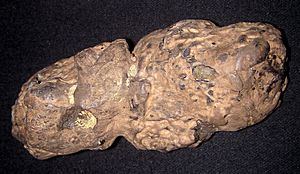Aquia Formation facts for kids
Quick facts for kids Aquia FormationStratigraphic range: Late Paleocene ~59.0–55.5Ma |
|
|---|---|

Thecachampsa crocodile coprolite (Aquia Formation; King George County, Virginia)
|
|
| Type | Geological formation |
| Unit of | Pamunkey Group |
| Sub-units | Paspotansa & Piscataway Members |
| Underlies | Nanjemoy Formation |
| Overlies | Brightseat Formation |
| Thickness | up to 100 feet (30 m) |
| Lithology | |
| Primary | Sandstone |
| Location | |
| Location | Hopewell, Virginia |
| Coordinates | 38°18′N 77°18′W / 38.3°N 77.3°W |
| Approximate paleocoordinates | 39°00′N 58°54′W / 39.0°N 58.9°W |
| Region | Maryland, New Jersey, Virginia |
| Country | |
| Extent | Upper Chesapeake Bay-James River |
| Type section | |
| Named for | Aquia Creek |
The Aquia Formation is a special layer of sandstone rock found in the eastern United States. It stretches from the top of the Chesapeake Bay all the way down to the James River in Hopewell, Virginia. This rock layer is made mostly of sandy material mixed with clay, silt, and lots of ancient shells. It also contains a green mineral called glauconite. Scientists believe this rock formation was created during a time called the Paleocene epoch, many millions of years ago. The Aquia Formation got its name from Aquia Creek, where you can see it clearly in the cliffs along the water.
Contents
What is the Aquia Formation Made Of?
When you see the Aquia Formation uncovered, it often looks dark green or gray-green. It has a lot of clay and is made of fine to medium-sized sand grains. Sometimes, you can find layers of hardened shells within the rock.
This rock layer can be anywhere from 0 to 100 feet (about 30 meters) thick. At the very bottom of the Aquia Formation, you might find quartz and small pebbles that contain phosphorus. There are also often thin, hard layers of shells or "rock" within the formation. These hard layers are more common in areas south of the James River.
How Does the Aquia Formation Fit In?
The Aquia Formation is like a middle layer in a stack of rock formations. Above it is another rock layer called the Nanjemoy Formation. Below it, you'll find the Brightseat Formation.
The Aquia Formation itself is divided into two main parts, or "members." The lower part is called the Piscataway member. The upper part is known as the Paspotansa member.
How Old is the Aquia Formation?
Scientists estimate that the Aquia Formation is very old, dating back about 59.0 to 55.5 million years ago. The lower Piscataway member is thought to be slightly older, from 59 to 56.25 million years ago. The upper Paspotansa member is a bit younger, dating from 56 to 55.5 million years ago. This means it formed during the Paleocene epoch.
What Fossils Are Found in the Aquia Formation?
The Aquia Formation is a treasure chest for fossils, showing us what life was like millions of years ago. Most of the fossils found here are from sea creatures, as this area was once covered by an ancient ocean.
Ancient Fish and Sharks
Many types of ancient fish have been found here. These include bony fish like Lepisosteus, Ostracion, and Phyllodus.
Sharks were also common in these ancient waters. Some of the shark fossils include Otodus obliquus, which was a large shark, and various types of Carcharias and Striatolamia.
Rays and Other Sea Creatures
Besides sharks, different kinds of rays, like Myliobatis and Dasyatis, have been discovered. These are flat-bodied fish related to sharks.
Reptiles of the Past
Fossils of ancient reptiles, especially crocodiles, are also present. You might find remains of Thecachampsa and Thoracosaurus, which were crocodile-like creatures. Ancient turtles like Trionyx have also been found.
Rare Mammals and Birds
It's very rare to find fossils of mammals or birds in the Aquia Formation. This suggests that these animals were not common in the ancient ocean environment where the formation was created.
Shells and Molluscs
The Aquia Formation is full of mollusc fossils, especially shells.
- Gastropods are snails, and Turritella snail shells are extremely common here.
- Bivalves are creatures with two shells, like clams and oysters. Many types have been found, including Cucullaea gigantea and Ostrea (oysters).
- Cephalopods are creatures like squids and octopuses. While not as common, Cimomia marylandensis (an ancient type of nautilus) is sometimes found.
See also
 In Spanish: Formación Aquia para niños
In Spanish: Formación Aquia para niños

